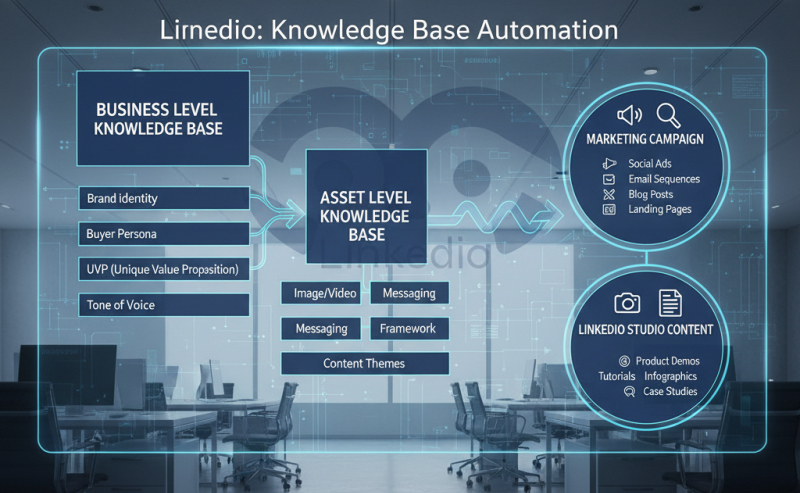You’re juggling orders, fixing supply delays, answering customer questions, and, if you’re anything like most #MSME owners I meet, trying to keep your marketing consistent on top of everything else. That’s where a business knowledge base becomes less of a luxury and more of a survival tool.
Imagine having a single, living source that captures your brand’s identity, your buyer personas, your unique value proposition, and the voice each piece of content should use. Suddenly, producing social posts, product descriptions, and local outreach materials doesn’t require re-writing your brand story every week.
Here’s the thing: many small teams try templates, freelancers, or ad-hoc content calendars, and the result is scattered messaging and lost time.
I’ve seen #founders spend half a day rewriting product descriptions because each team member “speaks” differently.
This article argues that building a practical business knowledge base, one that aligns business-level brand identity to asset-level tone, can drastically cut content time, improve customer trust, and make automation actually useful. You’ll learn what a business knowledge base is, why alignment between brand and asset tone matters, an actionable roadmap for creating one affordably, and how to measure results without getting lost in vanity metrics.
Along the way I’ll share real-world observations, a short case example, and common objections with pragmatic answers. Let’s dive in.
What is a business knowledge base, and why it matters
A business knowledge base is more than folders of documentation, business plans, logos and a one-paragraph mission statements. At its best, it’s a structured repository that captures:
- Core business function & industry competitiveness.
- Core brand identity: UVP, mission, core values
- Buyer personas: motivations, objections, language they use
- Tone and messaging pillars for different asset types (website, email, product labels, community outreach)
- Reusable content elements: taglines, proof points, FAQ answers, product specs
Why this matters:
When your messaging is codified, every email, social post, or product asset can be generated or reviewed against the same rules. That consistency builds recognition and trust, especially in local markets where word-of-mouth and reputation matter more than ever.
What I’ve noticed in the industry: teams that treat messaging as a living dataset (not a static PDF) win time and credibility. Tools that can map business-level voice into asset-specific tone—so an Instagram caption sounds friendly while an Linkedin post stays formal—are a game-changer for small teams.
How alignment of brand, asset, and content tone saves you time and money:
Think of brand identity as the orchestra and asset tone as the instrument each player uses. You want the same song, but the violin plays differently than the drums. When that mapping is explicit, content production becomes predictable.
Benefits:
- Faster content creation: Templates and tone rules reduce back-and-forth and revisions.
- Better conversions: Clear, consistent messaging reduces customer confusion and increases trust.
- Scalable automation: AI tools and marketing platforms perform better when they pull from a structured knowledge base.
Example (mini anecdote):
A neighbourhood foods co-op had three people writing product descriptions. One wrote poetic stories, another used technical measurements, and a third wrote short bullet points. After documenting one buyer persona and two-tone templates, they automated 70% of product descriptions and cut revision time by half. The descriptions still felt local and authentic, because the knowledge base encoded those specifics.
Research snapshot: While you don’t need complex studies to see the difference, multiple industry reports indicate consistent brand presentation helps recognition and drives measurable performance improvements. Bottom line: a small upfront investment in structure usually pays back quickly.
A practical, low-cost roadmap for MSMEs: Linkedio will automate it all in minutes... or you can do it manually:
You don’t need an enterprise budget to build a useful business knowledge base. Start small and iterate.
1. Audit what you already have (1–2 hours)
– Collect your homepage copy, a few social posts, an invoice template, and your most common customer messages.
2. Document the essentials (2–4 hours)
– UVP: one sentence that answers “why choose you?”
– 1–2 buyer personas: name, main need, how they talk
– 3 tone pillars: e.g., friendly, practical, community-first
3. Create asset templates (3–6 hours)
– Website headline + subheads, product description template (hook, benefit, specs), two email templates
4. Map business-to-asset tone
– For each asset, define how formal, how emotive, and what vocabulary to use
5. Choose simple tools to host it
– A shared document or lightweight wiki is fine. Later, integrate with a content tool that can use this as structured input—this is where platforms like Linkedio (which generate business knowledge bases and align tone automatically) add value.
6. Governance and maintenance
– Assign one person to own updates. Revisit quarterly and after major changes (new product, new market).
This incremental approach answers the most common objections: “Is it expensive?” No, start with a document. “Is it technical?” No, focus on clarity, not complex integrations. “Will it feel robotic?” Not if you codify the specific human details of your community and customers and applies it to your content tone per platform.
The above explains only the initial cost of getting started manually. With Linkedio you can automatically create your knowledge base from your existing documentation, website and content, or you can do it manually and generate buyer’s personal, UVP’s and tones from your manual updates.
Addressing objections and measuring impact:
Let’s be honest, some worries are valid: “Will this make my communications generic?” “How do I track whether it’s working?” Here are practical responses.
On authenticity: Structure doesn’t remove personality. It preserves it. When you capture local phrases, customer concerns, and real proof points, automation echoes your authentic voice rather than replaces it.
On costs and complexity: Treat the first version as an MVP. A one-page knowledge base is better than none. Choose integrations later based on observed time savings.
On privacy and governance: Keep sensitive customer data out of the public knowledge base and use role-based access for internal systems.
Metrics to watch (start simple):
- Time per asset (how long it takes to produce a social post, product page, email)
- Conversion lift (A/B test pages with and without aligned tone)
- Organic traffic and keyword ranking for core local queries
- Community feedback and repeat customer rate (qualitative but powerful)
“Consistency in how you say who you are is not marketing fluff—it’s a productivity lever. Treat your messaging as data, and your content tools will stop guessing.”
Consistency is everything and that’s what Linkedio does, it generates recommended amounts of content for approval then automatically posts the content when your target audience is online. Additionally, analytics is central to the solution and is monitored from post to campaign to business level impact.
How this helps the different people in your team
- If you’re Anele (founder): you’ll get consistent content without burning your day, templates and a living knowledge base let you delegate with confidence.
- If you’re Maya (marketing lead): linking your SEO and campaign strategy to a formal knowledge base means fewer rewrites and better organic performance.
- If you’re Andrew (program manager): a documented knowledge base supports governance, impact tracking, and replicable community programs.
- If you’re Thabo (operations/owner): automation becomes reliable because the rules are clear—less manual correction, fewer errors.
Conclusion
Creating a business knowledge base is not a one-time checkbox, it’s a practical, scalable discipline that makes your marketing smarter and your operations leaner. Linkedio does this automatically and updates it whenever your content is updated.
Start small: document your UVP, capture one or two buyer personas, and define tone rules for your most critical assets. If you do this, you’ll find content creation becomes less of a guessing game and more of a repeatable process that builds local trust. Linkedio does this automatically from URL automation and manual asset creation.
If you’re curious to see how aligning business-level identity to asset-level tone works in practice, consider piloting a single asset (like product pages or email campaigns) using the steps above. Over time, this steady work compounds into clearer messaging, faster execution, and stronger community reputation—which is exactly what local #MSMEs need.



